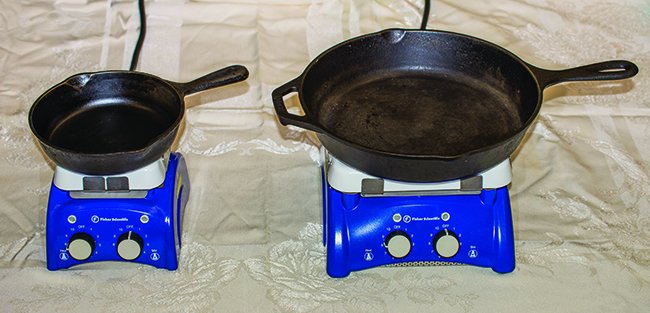| << Chapter < Page | Chapter >> Page > |
The larger cast iron frying pan, while made of the same substance, requires 90,700 J of energy to raise its temperature by 50.0 °C. The larger pan has a (proportionally) larger heat capacity because the larger amount of material requires a (proportionally) larger amount of energy to yield the same temperature change:
The specific heat capacity ( c ) of a substance, commonly called its “specific heat,” is the quantity of heat required to raise the temperature of 1 gram of a substance by 1 degree Celsius (or 1 kelvin):
Specific heat capacity depends only on the kind of substance absorbing or releasing heat. It is an intensive property—the type, but not the amount, of the substance is all that matters. For example, the small cast iron frying pan has a mass of 808 g. The specific heat of iron (the material used to make the pan) is therefore:
The large frying pan has a mass of 4040 g. Using the data for this pan, we can also calculate the specific heat of iron:
Although the large pan is more massive than the small pan, since both are made of the same material, they both yield the same value for specific heat (for the material of construction, iron). Note that specific heat is measured in units of energy per temperature per mass and is an intensive property, being derived from a ratio of two extensive properties (heat and mass). The molar heat capacity, also an intensive property, is the heat capacity per mole of a particular substance and has units of J/mol °C ( [link] ).

Liquid water has a relatively high specific heat (about 4.2 J/g °C); most metals have much lower specific heats (usually less than 1 J/g °C). The specific heat of a substance varies somewhat with temperature. However, this variation is usually small enough that we will treat specific heat as constant over the range of temperatures that will be considered in this chapter. Specific heats of some common substances are listed in [link] .
| Specific Heats of Common Substances at 25 °C and 1 bar | ||
|---|---|---|
| Substance | Symbol ( state ) | Specific Heat (J/g °C) |
| helium | He( g ) | 5.193 |
| water | H 2 O( l ) | 4.184 |
| ethanol | C 2 H 6 O( l ) | 2.376 |
| ice | H 2 O( s ) | 2.093 (at −10 °C) |
| water vapor | H 2 O( g ) | 1.864 |
| nitrogen | N 2 ( g ) | 1.040 |
| air | 1.007 | |
| oxygen | O 2 ( g ) | 0.918 |
| aluminum | Al( s ) | 0.897 |
| carbon dioxide | CO 2 ( g ) | 0.853 |
| argon | Ar( g ) | 0.522 |
| iron | Fe( s ) | 0.449 |
| copper | Cu( s ) | 0.385 |
| lead | Pb( s ) | 0.130 |
| gold | Au( s ) | 0.129 |
| silicon | Si( s ) | 0.712 |
If we know the mass of a substance and its specific heat, we can determine the amount of heat, q , entering or leaving the substance by measuring the temperature change before and after the heat is gained or lost:
In this equation, c is the specific heat of the substance, m is its mass, and Δ T (which is read “delta T”) is the temperature change, T final − T initial . If a substance gains thermal energy, its temperature increases, its final temperature is higher than its initial temperature, T final − T initial has a positive value, and the value of q is positive. If a substance loses thermal energy, its temperature decreases, the final temperature is lower than the initial temperature, T final − T initial has a negative value, and the value of q is negative.

Notification Switch
Would you like to follow the 'Chemistry' conversation and receive update notifications?